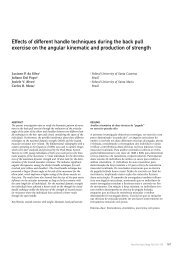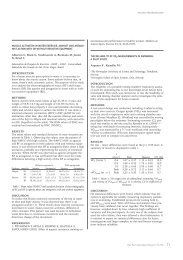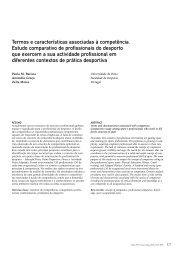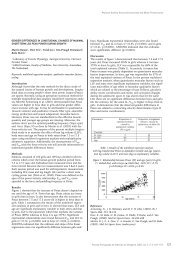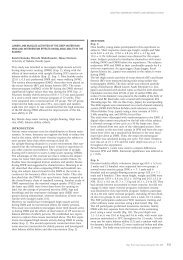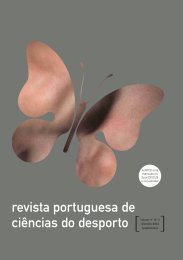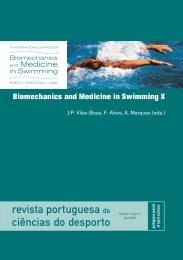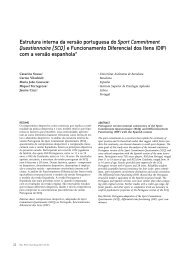download PDF - Faculdade de Desporto da Universidade do Porto
download PDF - Faculdade de Desporto da Universidade do Porto
download PDF - Faculdade de Desporto da Universidade do Porto
Create successful ePaper yourself
Turn your PDF publications into a flip-book with our unique Google optimized e-Paper software.
228<br />
J. Rodrigo Pauli, Luciana Souza, Gustavo Rogatto, Ricar<strong>do</strong> Gomes, Eliete Luciano<br />
64. Luciano E, Carneiro EM, Carvalho CRO, Carvalheira JBC,<br />
Perez SB, Reis MAB, Saad MJA, Boschero AC, Velloso LA.<br />
(2002). Endurance training improves responsivenes to<br />
insulin and modulates insulin signal transduction through<br />
the phosphatidylinositol 3-Kinase/ Akt-1 pathway. Eur J<br />
En<strong>do</strong>crinol 12 (2): 202-209.<br />
65. Gomes RJ, Caetano FC, Mello MAR, Luciano E. (2005).<br />
Effect of Chronic Exercise on Growth Factors in Diabetic<br />
Rats. Journal of Exercise Physiology 8 (2): 16-23.<br />
66. Pauli JR, Rodrigues Júnior JC, Antunes DFR, Luciano E.<br />
(2003). Treinamento físico e administração <strong>de</strong> insulina:<br />
efeitos sobre o metabolismo <strong>de</strong> carboidratos e proteínas.<br />
Motriz 9 (2): 71-74.<br />
67. Diabetes Prevention Program Research Group. (2002).<br />
Reduction of the inci<strong>de</strong>nce of type 2 diabetes with lifestyle<br />
intervention or metformin. N Engl J Med 346: 393-403.<br />
68. Kump DS, Booth FW. (2005). Alterations in insulin receptor<br />
signalling in the rat epitrochlearis muscle upon cessation<br />
of voluntary exercise. J Physiol 562 (3): 829-838.<br />
69. Booth FW, Chakravarthy MV, Spangenburg EE. (2002).<br />
Exercise and gene expression: physiological regulation of<br />
the human genome through activity. J Physiol 543 (2):<br />
399-411.<br />
70. Mikines KJ, Sonne B, Farrel PA. (1988). Effect of physical<br />
exercise on sensitivity and responsiveness to insulin in<br />
humans. Am J Physiol 254: E248-259.<br />
71. Stubbs CO, Lee JA. (2004). The obesity epi<strong>de</strong>mic: both<br />
energy intake and physical activity contribute. MJA 181<br />
(9): 489-491.<br />
72. Hardman AE. (1996). Exercise in the prevention of atherosclerotic,<br />
metabolic and hypertensive diseases: a review.<br />
J Sports Sci 14: 201-218.<br />
73. Francischi RP, Pereira LO, Lancha Júnior AH. (2001).<br />
Exercício, comportamento alimentar e obesi<strong>da</strong><strong>de</strong>: revisão<br />
<strong>do</strong>s efeitos sobre a composição corporal e parâmetros<br />
metabólicos. Rev Paul Educ Fís 15 (2):117-140.<br />
74. Mensink M, Blaak EE, Vi<strong>da</strong>l H, Brun TWA, Glatz JFC,<br />
Saris WHM. (2003). Lifestyle changes and lipid metabolism<br />
gene expression and protein content in skeletal muscle<br />
of subjects with impaired glucose tolerance.<br />
Diabetologia 46: 1082-1089.<br />
75. Seip RL, Semenkovich CF. (1998). Skeletal muscle lipoprotein<br />
lipase; molecular regulation and physiological effects<br />
in relation to exercise. Exerc Sport Sci Rev 26: 191-218.<br />
76. French AS, Story M, Jeffery RW. (2001). Environmental<br />
influences on eating and physical activity. Annu Rev Public<br />
Health 22: 309-335.<br />
77. Bouchard C, Shephard RJ, Stephens T. (eds). (1994).<br />
Physical activity, fitness and health: Internacional proceeedings<br />
and consensus statement. Champaign: Human Kinetics.<br />
78. Arroll B, Beaglehole R. (1992). Does physical activity<br />
lower blood pressure? A critical review of the clinical<br />
trials. Journal of Clinical Epi<strong>de</strong>miology 45: 439-447.<br />
79. Shen W, Zhang X, Wolin MS, Sessa W, Hintze TH. (1995).<br />
Nitric oxi<strong>de</strong> production and NO synthase gene expression<br />
contribute to vascular regulation during exercise. Med Sci<br />
Sports Exerc 8: 1125-1134.<br />
80. Kingwell BA. (2000). Nitric-oxi<strong>de</strong>-mediated regulation<br />
during exercise: effects of training in health and cardivascular<br />
disease. FASEB J 14: 1685-1696.<br />
81. Tanabe T, Mae<strong>da</strong> S, Miyauchi T, Iemitsu T, Takanashi M,<br />
Irukayama-Tomobe Y, Yokota T, Ohmori H, Matsu<strong>da</strong> M.<br />
Rev Port Cien Desp 6(2) 217–228<br />
(2002). Exercise training improves ageing-induced <strong>de</strong>creased<br />
in eNOS expression of the aorta. Acta Physiol Scand 178<br />
(1): 3-10.<br />
82. Wojtaszewski JFP, Birk JB, Frosig C, Holten M, Pilegaard<br />
H, Dela F. (2005). 5’AMP activated protein kinase expression<br />
in human skeletam muscle: effects of strenght training<br />
and type 2 diabetes. J. Physiol 564 (2): 563-573.<br />
83. Mcgee SL, Howlett KF, Starkie RL Cameron-mith D, Kemp<br />
BE, Hargraves M. (2003). Exercise increases nuclear<br />
AMPK α2 in numan skeletal muscle. Diabetes 52: 926-928.<br />
84. Hutber CA, Hardie DG, Win<strong>de</strong>r WW. (1997). Electrical<br />
stimulation inactivates muscle acetyl-CoA carboxylase and<br />
increases AMP’ activated protein kinase. Am. J. Physiol 272<br />
(2): E262-266.<br />
85. Hayashi T; Hirshman MF; Fujii N; Habinowski SA;<br />
Witters LA; Goodyear LJ. (2000). Metabolic stress and<br />
altered glucose transport activation of AMP-activated<br />
protein kinase as a unifying coupling mechanism.<br />
Diabetes 49 (4): 527-531.<br />
86. Stephens TJ; Chen ZP; Canny BJ; Michell BJ; Kemp BE;<br />
McConell GK. (2002). Progressive increases in human skeletal<br />
muscle AMPK alpha 2 activity and ACC phosphorylation<br />
during exercise. Am J Physiol En<strong>do</strong>crinol Metab 282 (3):<br />
E688–E694.<br />
87. Musi N, Yu H, Goodyear LJ. (2002). AMP-activated protein<br />
kinase regulation and action in skeletal muscle during<br />
exercise. Biochemical Society Transactions 31: 191-195.<br />
88. Win<strong>de</strong>r WW, Holmes BF, Rubink DS, Jensen EB, Chen M,<br />
Holloszy JO. (2000). Activation of AMP-activated protein<br />
kinase increases mitochondrial enzymes in sckeletal muscle.<br />
J Appl Physiol 88: 2219-2226.<br />
89. Musi N, Fujii N, Hirshiman MF. (2001). AMP-activated<br />
protein kinase (AMPK) is activated in muscle of subjects<br />
with type 2 diabetes during exercise. Diabetes 50: 921-927.<br />
90. Lau P, Bailey P, Dowhan DH, Muscai GE. (1999).<br />
Exogenous expression of a <strong>do</strong>minant negative RORRalpha<br />
1 vector in muscle cells impairs differentiation: RORalpha<br />
1 directly interacts with p300 and myoD. Nucleic Acids Res<br />
27: 411-420.<br />
91. Tanaka T, Yamamoto J, Iwasaki S, Asaba H, Hamura H,<br />
Ike<strong>da</strong> Y. (2003). Activation of peroxisome proliferator-activated<br />
receptor <strong>de</strong>lta induces fatty acid beta-oxi<strong>da</strong>tion in<br />
skeletal muscle and attenuates metabolic syndrome. Proc<br />
Natl Acd Sci 100: 15924-15929.<br />
92. Henever AL, He W, Barak Y, Le J, Bandyopadhyay G, Olson<br />
P. (2003). Muscle-specific Pparg <strong>de</strong>letion causes insulin<br />
resistance. Nat Med 9: 1491-1497.<br />
93. Muscat GE, Wagner BL, Hou J, Tangirala RK, Bischoff E,<br />
Roh<strong>de</strong> P. (2002). Regulation of cholesterol homeostasis<br />
and lipid metabolism in skeletal muscle by liver X receptor.<br />
J Biol Chem 277: 40722-40728.<br />
94. Muio DM, Way JM, Tanner CJ, Winegar DA, Kliewer SA,<br />
Houmard JA. (2002). Peroxisome proliferator-activatred<br />
receptor-alpha regulates fatty acid utilization in primary<br />
human skeletal muscle cells. Diabetes 51: 901-909.<br />
95. Wang YX, Zhang CL, Yu RT, Cho HK, Nelson MC, Bayuga-<br />
Ocampo CR. (2004). Regulation of muscle fiber type and<br />
running endurance by PPAR<strong>de</strong>lta. Plos Biol 2:e294.



